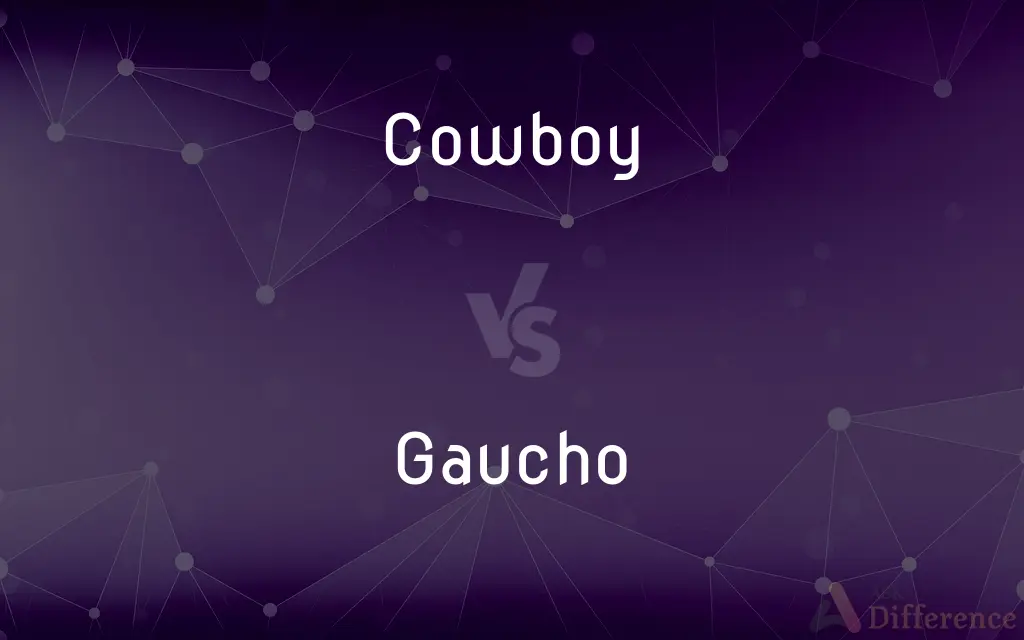Cowboy vs. Gaucho — What's the Difference?
By Fiza Rafique & Maham Liaqat — Updated on March 22, 2024
Cowboys are iconic figures of the American West, known for cattle herding and horse riding, while Gauchos are South American horsemen, renowned for their skills in the Pampas of Argentina, Uruguay, and Brazil.

Difference Between Cowboy and Gaucho
Table of Contents
ADVERTISEMENT
Key Differences
Cowboys originated in the United States, particularly in the western regions, becoming symbolic figures of American frontier culture. They were primarily involved in cattle ranching, driving herds across vast distances, and managing livestock on ranches. Gauchos, on the other hand, are the South American counterparts, especially prevalent in Argentina, Uruguay, and southern Brazil. They played a similar role in their respective regions, known for their exceptional horseback riding skills and livestock herding in the vast Pampas grasslands.
The cowboy culture is often associated with the late 19th-century American West, marked by the cattle drive era, where cowboys drove cattle from Texas to railheads in Kansas. This era, though relatively short-lived, left a lasting imprint on American culture, depicted in numerous movies, books, and songs. Gauchos, with their origins in the 18th century, are deeply integrated into the national identities of their countries, embodying the spirit of freedom and the open grasslands. Their lifestyle and traditions are celebrated in literature, music, and folklore.
Cowboys are known for their distinctive attire, including cowboy hats, boots, spurs, and chaps, developed to protect them from the harsh conditions of the trail and ranch work. Gauchos are also recognized for their unique clothing, such as bombachas (baggy trousers), wide-brimmed hats, and boots, complemented by a facón (large knife) that was carried for work and protection.
While both cowboys and gauchos share a connection to cattle herding and horse riding, their skills and traditions have been shaped by their distinct environments. Cowboys often participated in rodeos that evolved from the skills required for cattle ranching, including roping, steer wrestling, and bronc riding. Gauchos are renowned for their skills in doma india, a method of horse taming and training that emphasizes a respectful and mutual understanding between the horse and rider.
The legacy of cowboys and gauchos continues to be celebrated in modern times through festivals, rodeos, and cultural events, preserving the heritage and traditions of these iconic figures of the American and South American frontiers. While their ways of life have adapted to contemporary times, the spirit of the cowboy and the gaucho endures as symbols of resilience, independence, and a deep connection to the land and livestock they tend.
ADVERTISEMENT
Comparison Chart
Origin
United States, particularly the West.
South America, especially Argentina, Uruguay, and Brazil.
Era
Late 19th century, cattle drive era.
18th century onwards.
Cultural Significance
Symbolic of American frontier culture.
Integral to national identities, embodying freedom and skill.
Attire
Cowboy hats, boots, spurs, chaps.
Bombachas, wide-brimmed hats, boots, facón.
Skills
Cattle herding, horse riding, rodeo events.
Horseback riding, livestock herding, doma india.
Environment
Ranges, ranches, and the Great Plains.
Pampas grasslands.
Legacy
Celebrated in movies, music, and rodeos.
Preserved in literature, music, and folklore.
Compare with Definitions
Cowboy
A cattle herder in the American West.
The cowboy skillfully guided the cattle along the trail.
Gaucho
A skilled horseman and cattle herder from South America's Pampas.
The gaucho deftly navigated the open grasslands, herding the cattle with ease.
Cowboy
Known for their rugged lifestyle and horse riding skills.
Cowboys often spent long days in the saddle, managing the herd.
Gaucho
Distinguished by traditional attire, including bombachas.
Dressed in bombachas and a wide-brimmed hat, the gaucho's attire was perfectly suited to life on the Pampas.
Cowboy
Characterized by distinctive western attire.
His cowboy attire, complete with a wide-brimmed hat and spurs, was emblematic of his profession.
Gaucho
Renowned for their doma india horse training technique.
The gaucho's gentle approach to horse training, known as doma india, emphasized a harmonious relationship with the animal.
Cowboy
Participates in rodeo events, showcasing skills from ranch work.
The cowboy excelled in the rodeo, particularly in the bronc riding event.
Gaucho
Cultural icon in Argentina, Uruguay, and southern Brazil.
In Argentina, the gaucho is celebrated as a national symbol of resilience and cultural heritage.
Cowboy
Symbolizes American frontier spirit and culture.
The image of the cowboy, alone on the range, captures the essence of American independence and adventure.
Gaucho
Embodies the spirit of freedom and mastery of the land.
Gauchos are revered for their deep connection to the Pampas and their independent way of life.
Cowboy
A cowboy is an animal herder who tends cattle on ranches in North America, traditionally on horseback, and often performs a multitude of other ranch-related tasks. The historic American cowboy of the late 19th century arose from the vaquero traditions of northern Mexico and became a figure of special significance and legend.
Gaucho
A gaucho (Spanish: [ˈɡaut͡ʃo]) or gaúcho (Portuguese: [ɡaˈuʃu]) is a skilled horseman, reputed to be brave and unruly. The figure of the gaucho is a folk symbol of Argentina, Uruguay, Rio Grande do Sul in Brazil, and the south of Chilean Patagonia.
Cowboy
(especially in the western US) a man who herds and tends cattle, performing much of his work on horseback
They are always playing cowboys and Indians
Gaucho
A cowboy of the South American pampas.
Cowboy
A dishonest or careless person in business, especially an unqualified one
Cowboy coach firms are alleged to have flouted safety rules
Gaucho
Gauchos Calf-length pants with flared legs.
Cowboy
Work as a cowboy.
Gaucho
A cowboy of the South American pampas.
Cowboy
A hired man, especially in the western United States, who tends cattle and performs many of his duties on horseback. Also called cowman; also called regionally buckaroo, vaquero, waddy2. See Note at buckaroo
Gaucho
A proposed currency intended to be used by Argentina and Brazil to make interregional payments.
Cowboy
An adventurous hero.
Gaucho
One of the native inhabitants of the South American pampas, of Spanish-American descent. They live mostly by rearing cattle. Hence, a South American cowboy, especially on the pampas.
Cowboy
(Slang) A reckless person, such as a driver, pilot, or manager, who ignores potential risks.
Gaucho
A cowboy of the South American pampas
Cowboy
A man who tends free-range cattle, especially in the American West.
Cowboy
A man who identifies with cowboy culture, including wearing a cowboy hat and being a fan of country and western music.
Cowboy
(informal) A person who engages in reckless behavior, especially for the purpose of showing off.
Cowboy
A dishonest and/or incompetent independent tradesman.
Cowboy
A playing card of king rank.
Cowboy
(uncountable) cowboy pool
Cowboy
(intransitive) To work as a cowboy, herding cattle.
Cowboy
A cattle herder; a drover; specifically, one of an adventurous class of herders and drovers on the plains of the Western and Southwestern United States.
Cowboy
One of the marauders who, in the Revolutionary War infested the neutral ground between the American and British lines, and committed depredations on the Americans.
Cowboy
A hired hand who tends cattle and performs other duties on horseback
Cowboy
A performer who gives exhibitions of riding and roping and bulldogging
Cowboy
Someone who is reckless or irresponsible (especially in driving vehicles)
Common Curiosities
Who are the Gauchos?
Gauchos are South American horsemen, particularly from Argentina, Uruguay, and southern Brazil, skilled in herding cattle in the Pampas grasslands.
How do the lifestyles of cowboys and gauchos differ?
Cowboys and gauchos share similar lifestyles centered around cattle herding and horseback riding, but their traditions and cultural significance are shaped by their distinct environments and historical contexts.
Are cowboys and gauchos still present today?
Yes, both cowboys and gauchos still exist, though their roles have adapted to modern times. Their legacies are celebrated in cultural events and rodeos.
What skills are cowboys and gauchos renowned for?
Both are renowned for their exceptional horseback riding and cattle herding skills. Cowboys are also known for rodeo skills, while gauchos are noted for their doma india horse training method.
What is a cowboy?
A cowboy is a cattle herder from the American West, known for their horse riding skills and association with the cattle drive era.
How do gauchos contribute to South American culture?
Gauchos are integral to the national identities of Argentina, Uruguay, and southern Brazil, symbolizing freedom, skill, and a deep connection to the land.
How are cowboys and gauchos portrayed in media and entertainment?
Cowboys are frequently depicted in Western films and literature, while gauchos are celebrated in South American music, dance, and literature, often highlighting their skills, values, and way of life.
Can women be cowboys or gauchos?
Yes, women can and do participate in the roles and cultural lifestyles traditionally associated with cowboys and gauchos, often referred to as cowgirls and gaucho women, respectively.
Do cowboys and gauchos have any religious or spiritual practices associated with their lifestyle?
While not inherently religious, some cowboys and gauchos may incorporate spiritual beliefs or practices into their way of life, often influenced by the predominant religions and cultures of their regions.
What kind of clothing is associated with cowboys and gauchos?
Cowboys are known for their cowboy hats, boots, and chaps, while gauchos wear bombachas, wide-brimmed hats, and often carry a facón.
What are some common tools or equipment used by cowboys and gauchos?
Cowboys often use lassos, saddles, and spurs, while gauchos are known for their use of the facón, boleadoras, and distinctive saddles.
What environmental challenges do cowboys and gauchos face?
Both cowboys and gauchos face environmental challenges related to climate, terrain, and changes in agricultural practices, which can impact their traditional ways of life and livestock management.
Are there any festivals or events that celebrate cowboy and gaucho culture?
Yes, there are numerous festivals and rodeos, such as the Calgary Stampede in Canada and the Fiesta de la Tradición in Argentina, that celebrate and preserve cowboy and gaucho culture and traditions.
What is the significance of the cowboy in American culture?
Cowboys are iconic figures representing the American frontier spirit, embodying themes of adventure, independence, and resilience.
How do modern cowboys and gauchos differ from their historical counterparts?
Modern cowboys and gauchos often incorporate technology and contemporary agricultural practices into their work, though they maintain many of the traditional skills and cultural elements of their predecessors.
Share Your Discovery

Previous Comparison
Poulet vs. Broiler
Next Comparison
Immediately vs. QuicklyAuthor Spotlight
Written by
Fiza RafiqueFiza Rafique is a skilled content writer at AskDifference.com, where she meticulously refines and enhances written pieces. Drawing from her vast editorial expertise, Fiza ensures clarity, accuracy, and precision in every article. Passionate about language, she continually seeks to elevate the quality of content for readers worldwide.
Co-written by
Maham Liaqat















































